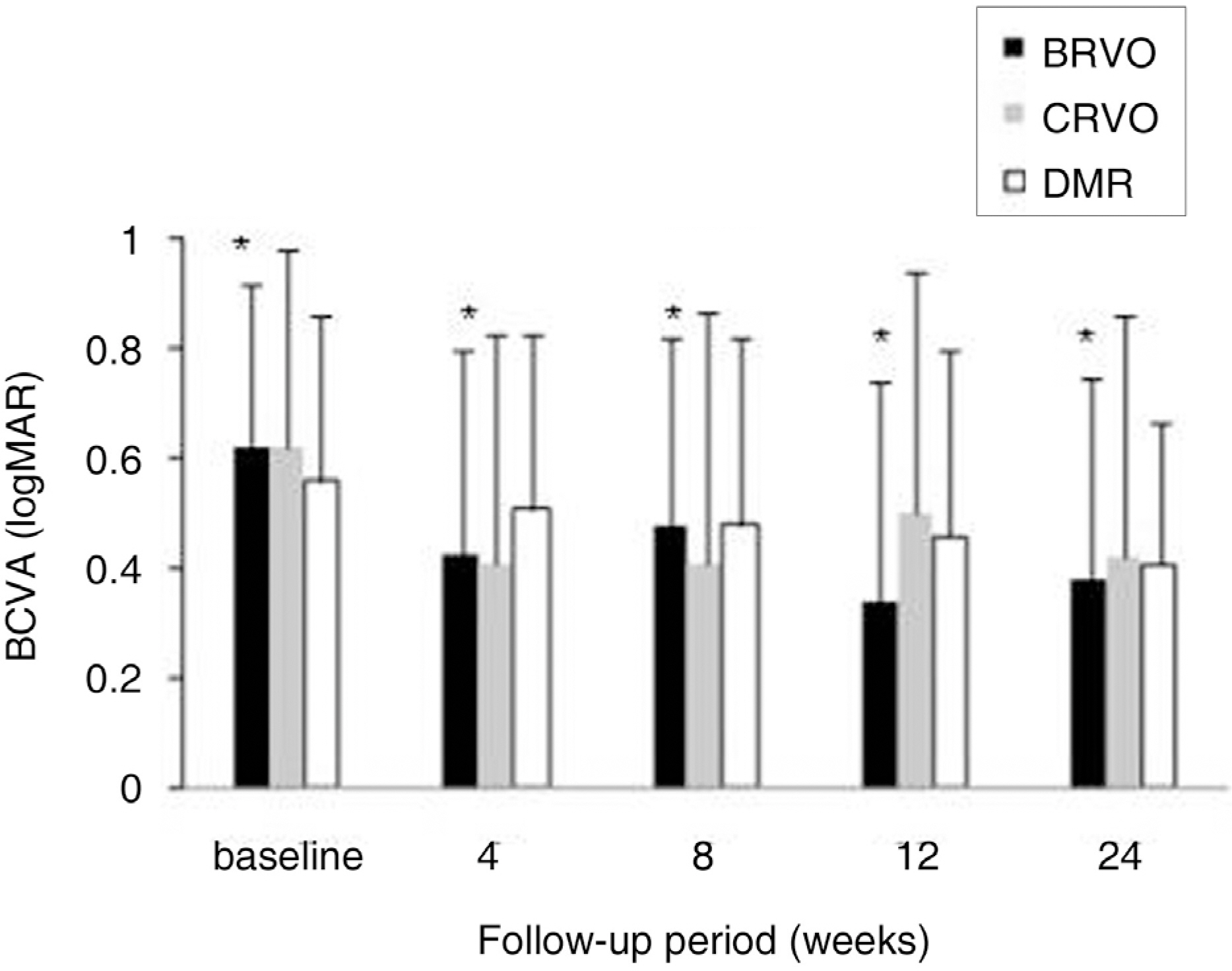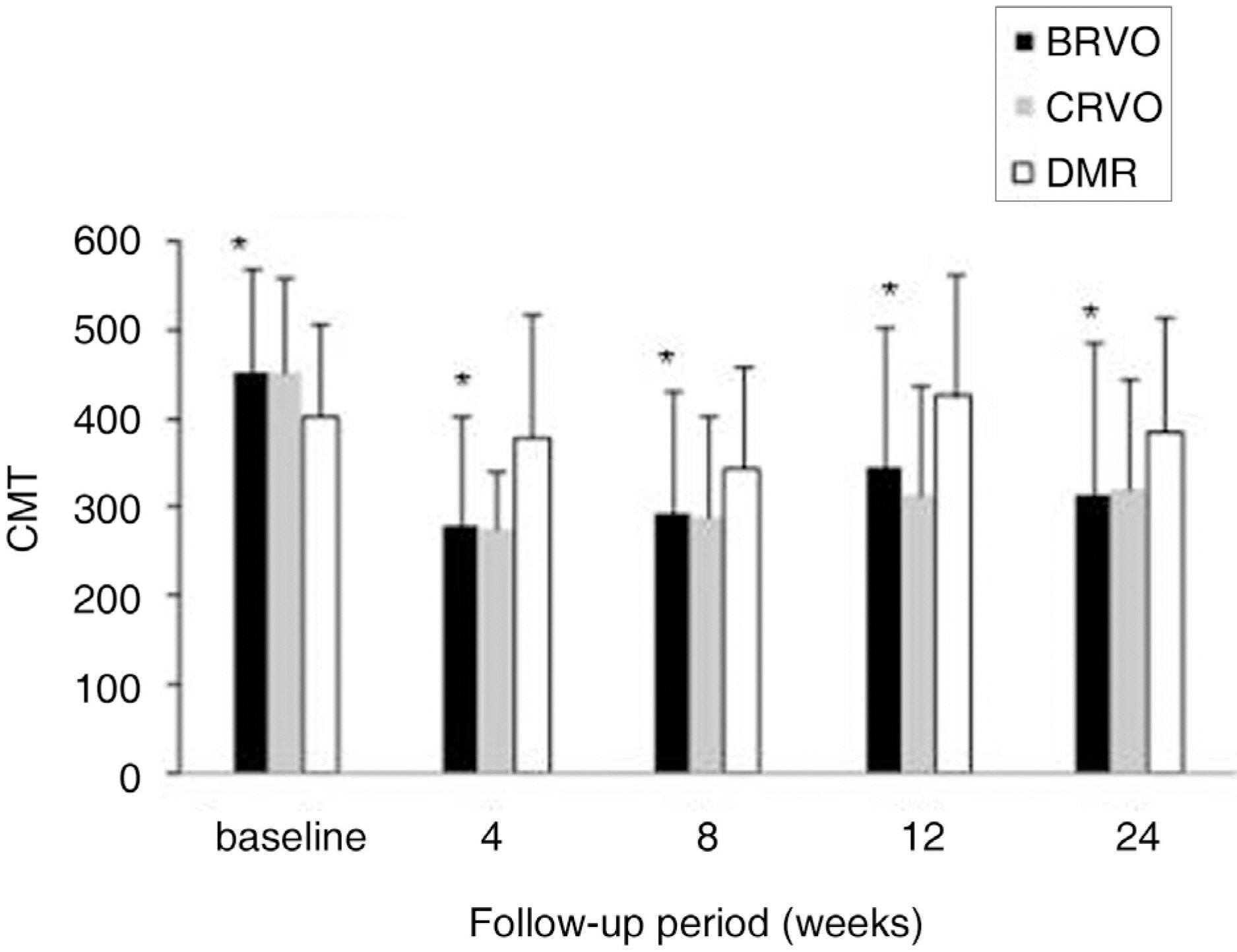J Korean Ophthalmol Soc.
2009 Aug;50(8):1232-1236. 10.3341/jkos.2009.50.8.1232.
The Efficacy of Intravitreal Bevacizumab in the Treatment of Macular Edema
- Affiliations
-
- 1Department of Ophthalmology, School of Medicine, Ewha Womans University, Seoul, Korea. leejhoph@ewha.ac.kr
- 2Department of Ophthalmology, National Medical Center, Seoul, Korea.
- KMID: 2212540
- DOI: http://doi.org/10.3341/jkos.2009.50.8.1232
Abstract
- PURPOSE
To investigate the efficacy in best corrected visual acuity (BCVA) and central macularthickness after intravitreal bevacizumab injection in patients with macular edema. METHODS: Patients with macular edema due to branch retinal vein occlusion, central retinal vein occlusion, and diabetic retinopathy received intravitreal injection of bevacizumab (2.5 mg/0.1cc). Complete ophthalmic examinations including best corrected visual acuity and optical coherence tomography (OCT) were performed at baseline and follow-up visits for 6 months. RESULTS: In macular edema secondary to branch retinal vein occlusion, the mean BCVA improved from logMAR 0.62+/-0.30 at baseline to logMAR 0.43+/-0.37 at 1 month, 0.34+/-0.40 at 3 months and 0.38+/-0.37 at 6 months (p<0.05). The mean central macular thickness decreased from 451.2+/-118.9 micrometer at baseline to 280.3+/-124.6 micrometer at 1 month, 345.8+/-157.1 micrometer at 3 months and 312.9+/-174.4 micrometer at 6 months (p<0.05). In macular edema secondary to central retinal vein occlusion and diabetic retinopathy, visual improvement and macular thickness reduction were not statistically significant. CONCLUSIONS: Intravitreal bevacizumab injection appears to be more effective for macular edema due to branch retinal vein occlusion than macular edema secondary to central retinal vein occlusion and diabetic retinopathy.
MeSH Terms
Figure
Reference
-
References
1. Ryan SJ. Nonproliferative diabetic retinopathy. Chew EY, Ferris FL III, editors. Retina. 4th ed.New York: Mosby, Elsevier Inc.;2006. 2:chap. 67.2. Nguyen QD, Shah SM, van Anden E, et al. Supplementaloxygen improves diabetic macular edema: a pilot study. Invest Ophthalmol Vis Sci. 2004; 45:617–24.3. Ozaki H, Hayashi H, Vinores SA, et al. Intravitreal sustained release of VEGF causes retinal neovascularization in rabbits and breakdown of the blood-retinal barrier in rabbits and primates. Exp Eye Res. 1997; 64:505–17.4. Derevjanik NL, Vinores SA, Xiao WH, et al. Quantitative assessment of the integrity of the blood-retinal barrier in mice. Invest Ophthalmol Vis Sci. 2002; 43:2462–7.5. Boyd SR, Zachary I, Chakravarthy U, et al. Correlation of increased vascular endothelial growth factor with neovasculari-zation and permeability in ischemic central retinal vein occlusion. Arch Ophthalmol. 2002; 120:1644–50.6. Funatsu H, Yamashita H, Noma H, et al. Aqueous humor levels of cytokines are related to vitreous levels and progression of diabetic retinopathy in diabetic patients. Graefes Arch Clin Exp Ophthalmol. 2005; 243:3–8.
Article7. Ferrara N, Hillan KJ, Gerber HP, Novotny W. Discovery and development of bevacizumab, an anti-VEGF antibody for treating cancer. Nat Rev Drug Discov. 2004; 3:391–400.
Article8. Spaide RF, Fisher YL. Intravitreal bevacizumab (Avastin) treatment of proliferative diabetic retinopathy complicated by vitreous hemorrhage. Retina. 2006; 26:275–8.
Article9. Michels S, Rosenfeld PJ, Puliafito CA, et al. Systemic bevacizumab (Avastin) therapy for neovascular age-related macular degeneration. Twelve-week results of an uncontrolled open-label clinical study. Ophthalmology. 2005; 112:1035–47.10. Avery RL, Pieramici DJ, Rabena MD, et al. Intravitreal bevacizu-mab (Avastin) for neovascular age-related macular degeneration. Ophthalmology. 2006; 113:363–72.
Article11. Iturralde D, Spaide RF, Meyerle CB, et al. Intravitreal bevacizu-mab (Avastin) treatment of macular edema in central retinal vein occlusion: a short-term study. Retina. 2006; 26:279–84.12. Vinores SA, Youssri AI, Luna JD, et al. Upregulation of vascular endothelial growth factor in ischemic and non-ischemic human and experimental retinal disease. Histol Histopathol. 1997; 12:99–109.13. Fischer S, Renz D, Schaper W, et al. In vitro effects of dexa-methasone on hypoxia-induced hyperpermeability and expression of vascular endothelial growth factor. Eur J Pharmacol. 2001; 411:231–43.
Article14. Nauck M, Karakiulakis G, Perruchoud AP, et al. Corticosteroids inhibit the expression of vascular endothelial growth factor gene in human vascular smooth muscle cells. Eur J Pharmacol. 1998; 341:309–15.15. Jonas JB, Kreissig I, Degenring R. Intraocular pressure after intravitreal injection of triamcinolone acetonide. Br J Ophthalmol. 2003; 87:24–7.
Article16. Martidis A, Duker JS, Greenberg PB, et al. Intravitreal triamcinolone for refractory diabetic macular edema. Ophthalmology. 2002; 109:920–7.
Article17. Ciardella AP, Klancnik J, Chiff W, et al. Intravitreal triamcinolone for the treatment of refractive diabetic macular edema with hard exudate: an optical coherence tomography study. Br J Ophthalmol. 2004; 88:1131–6.18. Rabena MD, Pieramici DJ, Castellarin AA, et al. Intravitreal bevacizumab (Avastin) in the treatment of macular edema secondary to branch retinal vein occlusion. Retina. 2007; 27:419–25.
Article19. Haritoglou C, Kook D, Neubauer A, et al. Intravitreal bevacizu-mab (Avastin) therapy for persistent diffuse diabetic macular edema. Retina. 2006; 26:999–1005.
Article
- Full Text Links
- Actions
-
Cited
- CITED
-
- Close
- Share
- Similar articles
-
- Macular Hole Formation after Intravitreal Injection of Bevacizumab for Diabetic Macular Edema
- Effect of High-dose Intravitreal Bevacizumab Injection on Refractory Idiopathic Choroidal Neovasculariz
- Comparison of Intravitreal Bevacizumab Alone Injection and Intravitreal Combination Low-Dose Bevacizumab-Triamcinolone Injection or Diabetic Macular Edema
- Effects of Intravitreal Bevacizumab Injection in 3 Types of Macular Edema Secondary to Branch Retinal Vein Occlusion
- Efficacy of Intravitreal Dexamethasone Implant for Diabetic Macular Edema According to Previous Responses to Bevacizumab



